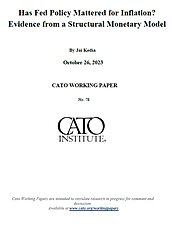A CMFA working paper from May 2023 (henceforth “CMFA VAR study”) utilized a structural monetary VAR and suggests that the Fed has a minimal effect on inflation. Most of the inflation over all future horizons and across sectors is determined primarily by supply shocks with monetary policy usually accounting for around 5% of inflation. At its peak – during the post-financial crisis period and only looking at longer term horizons – monetary policy accounts for roughly 10% of inflation. In short, the VAR evidence did not suggest that the Fed has much ability to manipulate inflation.
It is important to note that VARs are useful but ultimately simple tools to analyze macroeconomic relationships. Like with most empirical techniques, they come with their own set of pros and cons. In this manner, the simplicity of VARs is both pro and con. One benefit of this approach is that VAR coefficients are unrestricted since they are purely estimated from data and do not rely on any background micro-based model. As such, many academics use the VAR as the “true” model by which the economy operates and judge the success or failure of their fully specified model by how closely it matches the results from a VAR. Indeed, several empirical macroeconomists estimate the parameters from their structural models by a technique known as “impulse response matching”: In this method, the parameters of the structural model are set to match the business cycle predicted by a VAR.
However, the simplicity of the VARs does not allow for a detailed analysis of policy. A researcher must simply accept parameter estimates as a description of the data – there is no way to understand why a parameter is estimated to be a specific number. Given the simple nature of the variable relationships, even under structural identification methods such as those used in the CMFA VAR study, the link between economic theory and coefficients is weak. An additional concern, noted in the CMFA VAR study itself, is that it is impossible to disentangle the sources of demand and supply shocks since the VAR specification only includes 3 equations with corresponding exogenous error terms. It is understood that the output equation contains the demand shock, the inflation equation the supply shock, and the interest rate equation the monetary policy surprise, but no further breakdown is possible. This shortcoming makes it difficult to tell, for example, whether the supply shock comes from the labor market or the goods market? Such questions cannot be answered using the VAR method.


